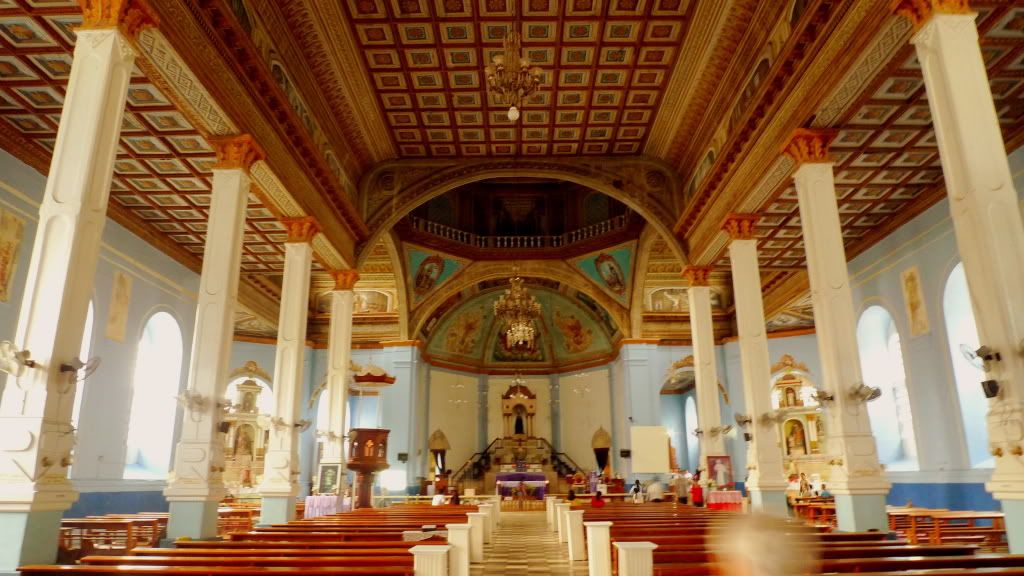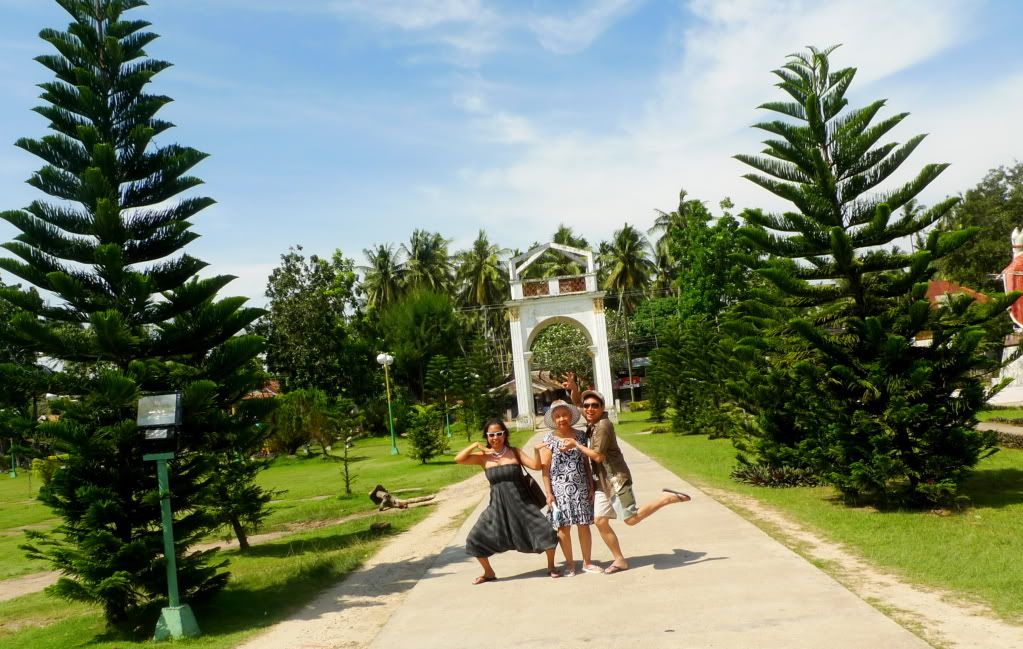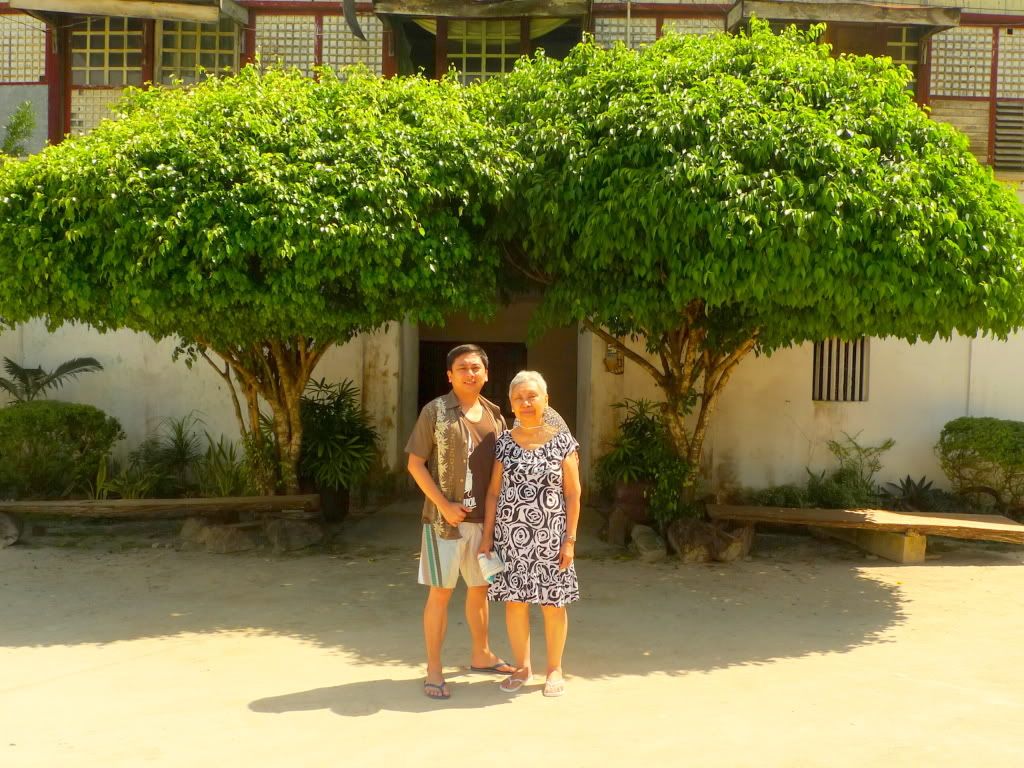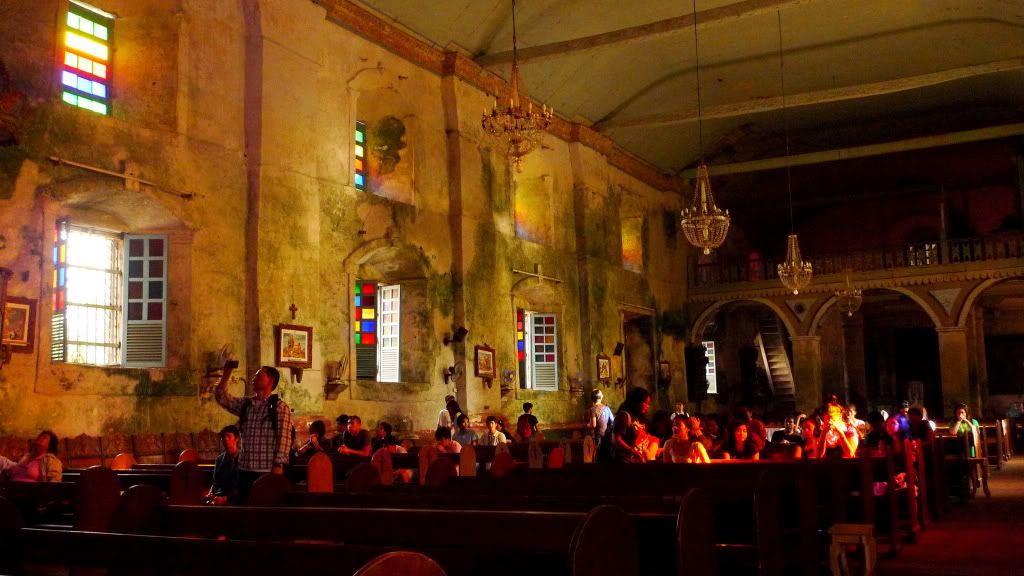Dauis / Panglao / Baclayon, Bohol, the Philippines
April 1 – 3, 2011
Bohol, already blessed with natural gifts – the Chocolate Hills and the tarsier, was embellished with some of the most visually dramatic Catholic churches in the country. I visited the province with my mother and sister, not on a spiritual journey – none of us Catholic, but for a more sensuous reason – for our love of heritage and art.

Dauis Church


The Church of Our Lady of the Assumption seemed out-of-place in this little town. With its tall horseshoe Byzantine arches at the facade, florid murals in the interior and stone towers on its grounds, it was solid evidence of foreign influence on our culture. How strange it must have been – this looming edifice of stone – to Boholanons of centuries past who lived in traditional houses of bamboo and grass.
The area around the church used to be fortified against Muslim raiders. The fortifications had since been dismantled by time and circumstance, save for a stone watch tower a few meters from the church, an enduring legacy of colonial power. The Boholanons were conflicted about this power that both conquered and protected them. These days, capitalism had replaced colonialism. The convent that housed Spanish friars was converted into a swanky souvenir shop and alfresco cafe.
Earlier that day, I had spotted the church from across Tagbilaran Bay. Its Gothic belfry, crowned by pointy projections, was unmistakable even from that distance. Dauis Church may not be considerably prodigious, but it had been an imposing presence in this little town, unrivaled for centuries.


Panglao Church
The sun was high when we got to San Agustin Parish Church. On a Sunday, between masses, we found the church lifeless and empty, its doors and windows flung wide open, letting in the radiant afternoon sunshine. Its interior, a long and hollow vault, exuded a warm pastel glow. It was at a vantage point near the altar that I quickly snapped a photo of Mom, her head and silver hair outlined by a halo of white light from the open front door.

The church’s trompe l’oeil ceiling painting was a glorious celebration of colors, shapes, and heavenly images. I looked up transfixed by its striking depth and vibrant colors in the tradition of exquisite Catholic art. Even the confessionals were symmetrically carved with flowers and birds. Finally a confession in the Garden of Eden, they seemed to convey.
We were lucky to have the church to ourselves. On the other hand, I would’ve wanted to see how the parishioners regarded these sublime works of art. Could they have been seduced by these tantalizing visions of heaven above them?


Baclayon Church
But all church visits in Bohol led to the Church of Our Lady of Immaculate Conception, the original headquarters of Spanish Jesuits in the province and one of the oldest churches in the country.


The church, made of cut coral stones cemented together by egg white from what must have been millions of eggs, a fact that Mom was fixated on, was massive. The Jesuits were guilty of forced labor on two counts – for the hens that hatched the eggs and for the men who cut the coral stones from seaside cliffs and constructed the church.
An eerie darkness enveloped the church despite throngs of tourists and local churchgoers. A claustrophobic chamber and the cavernous nave lent an oppressive air. In fact, the church once served as a dungeon for backsliding Boholanons.


The church was also a virtual prism; its stained glass windows refracted natural light into rainbow colors. Late afternoons in Baclayon Church cast these technicolor rays on pews and the prayerful. The effect beguiled Mom’s thoughts away from the egg whites in the masonry. In a moment of uncharacteristic initiative, she began conceptualizing art shots around these colorful lights.
Art and the Church – the combination was almost always surreal. Fra Lippo Lippi, a friar in Browning’s poem questioning the authority of the Church over art, enthused about God’s art – His creation:
The beauty and the wonder and the power,
Robert Browning
The shapes of things, their colours, lights and shades,
Changes, surprises, — and God made it all!
That may have been true of the natural world, but in the Church, they were all man-made. I could imagine the colonial era friars rousing reverence from the people with such artful use of lights and shades. Catholicism may have colonized the Philippines more than Spain did.
Thanks for reading! If you like my content, you may…












Gandwah! But you’ve only scratched the surface barely! Thought you’ve also included Loboc on your itinerary. 🙂
IKR! Bohol churches are awesome. But we didn’t have time to visit Loboc Church because of the river cruise. Next time. 🙂
Hope you had a great trip Aj. quite different places which i never heard before ..thx for the info
Twas amazing, Sheril! Come and visit! 🙂
ya one day i ll come to your country !! 🙂
Wow ..never been to Bohol..strange right?since im only here in Cebu…your pictures make me wanna visit bohol….by the way i am a fan of your blog..and i put it on my bloglist…
http://andak2008online.blogspot.com
Wow great pictures…makes me wanna visit Bohol asap!
Daghang salamat gyud, Andak, for the support. Much appreciated. 🙂
Hop on that SuperCat, now na! 😀 Seriously, it’s a sin of omission for someone from Cebu to not see Bohol. Hehe.
You should make your mom take more photographs 😉
Hahaha yeah she’s a natural. I wouldn’t mind being the model. 🙂
haha love this new experiment dear. but still, w/ or w/o photos, I love reading your narration. =) panalo ang photo na “forgive me mother for I have sinned”. haha
Confession of a shopaholic yan. 😀 Thanks Gael! Sayang di ako nakapag-workshop for point-&-shooters. I needed that, hehe.
Will share this with a friend who is going to Bohol in a few weeks.
Thanks Wowers! There are more wonderful churches in Bohol. Tell your friend to check the others out.
Wow.. Only in the Philippines! ganda talaga…
Pilipinas kay ganda nga naman. At maganda talaga ang Bohol. My favorite province. 🙂
Love the clever use of light in the last four photos especially Joy in Prayer.
The light was there; all I had to do was snap the photo. And the last 2 photos were conceptualized by Mom. 🙂
I’m running out of words, now. I guess I have exhausted whatever little I had in all your other posts. Let me think. I like Browning and the lines from Fra Lippo Lippi cannot be more true. How did catholicism reach Philippines, Age? The star of David in Belfry of Panglao Church is intriguing. Any Jewish connection?
The trivia of egg whites is quite fascinating.
Age, how did you feel at the end of the trip having visited so many churches? All enlightened and all? (winks).
Catholicism was Spain’s weapon of colonialism. Insanely effective considering that we’ve never learned Spanish but believed the Church – hook, line, and sinker. That’s how the Philippines became the only Christian country in Asia.
That star, I think, was a leftover decor from Christmas. It’s the star of Bethlehem in a Christian context, not Jewish.
Yeah, I can’t imagine egg whites as glue. And for stone! And it sticks for centuries! I wonder where all the albumin went though. If only we had info about the cholesterol levels of people that time then we’d know where. 🙂
Enlightened? Always. Each time I visit these places of worship, I glimpse the history and culture of that place. That’s always enlightening.
Thanks for still finding the words, Mrs. Sus. Made me realize that I must be discussing the same things in this blog. Time for a change, perhaps?
Manager!!!!! You already!!!!!! wala akong masabi!!!!! basta !!!
Me already…what?! Sabihin mo, please! 😀 Anyway, I’m glad you had time to comment on my blog. 🙂
ok….. awesome photographs….. specially love the one with your mom…. she is a really good model huh….. marunong mag emote si mommy…. hehehe…… Love the color of the sky dun sa unang photo…. galing din ng composition mo dun sa man in prayer and joy in prayer….. and i also like the framing of the cafe lawis….. awesome!
Whoa! That blew me away, idol! Coming from a photographer I truly look up to….
To be honest, I don’t really know composition and framing. I’d have to stop relying on fluke shots and really understand what I’m doing.
As for the emoting, obviously it’s in the blood. 😀
Great photos, AJ! I especially love the first one. And some history lesson there. Have you been to Siquijor yet? Lots of beautiful old churches there too.
And what a cool mom you have! 🙂
Thanks Reiza! Nope, haven’t set foot on Siquijor yet but would love to. More than the churches, I’d love to know the stories and myths (and chismis, hehe) about them. 🙂
Oh, and Mom is nonplussed by her coolness. 😀
Woah! Thanks for this. I failed to enter Dauis when I went there. Sarado. Cafe Lawis is like the one in Prom Night scene of Twilight. Yung magpapakagat sana sa leeg si Bella pero tinanggihan ni Edward. hahah! The rainbow colored stained glass.. ang luvleh! Sarap mag emote no? haha!
Epic fail, Kura! Major sayang. Natawa naman ako sa association mo. Twilight talaga. Interview with a Vampire generation ako eh. Can’t relate. 😀
Beautiful AJ and you have captured the spirit of the day very well! I have enjoyed this journey! Your Mom is quite the adventurer! How wonderful 🙂
Hola Nelieta! I’m the youngest in the family, a menopausal baby. My folks were middle-aged when I was growing up. I guess they’ve mellowed down by then. I’ve not really known their younger, more active selves. She told me she used to run up the stairs for several floors in college. I only get to see a bit, a teeny weeny bit, of that girl in Mom now when we’re traveling. 🙂
Really loved the story and the images. Your choice of composition is wonderful
http://jpweddingphotograpy.blogspot.com/2011/08/photographing-grizzly-bear-in-alaska.html
Wow! Thanks for the props, Jim!
i think you balanced text and photos well AJ. Especially good choice to use photos when the subject includes so much in lighting effects.
I loved this AJ..beautiful words and images..as always you amaze me1
Appreciate your generous words, Jim M. and Deanne! Simply a notation and capture of a wonderful memory.
Great pictures and descriptions 🙂 Nostalgic. Winner!
Mommy Ritz!!! Minsan lang mag-comment pero it’s a comment to end all comments! Haha! Serioso ba toh?!
i am a frequent visitor of you blogs. This one is jaw dropping. Kakatindig balahibo, like journey to the past. Can’t help not to leave a note.
It seems like shoots of a professional photographer PLUS your mom’s one and only shoot.
Stalker pala kita, Mommy Ritz. Sana paramdam ka ulit when you visit. But no, malayo sa pro shots ito. Pro bono lang. 😀
hahaha stalker…..hindi mo namamalayan nadikitan pala kita ng sound chip sa hair strand mo nung last eat out natin kaya alam ko lahat happenings about you. kaya, i need not make paramdam coz i’m always with ya!
Scared shitless! 😀
Name palang ng blog, nosebleed na! Love the entry AJ!
Ooooh noooo…I was hoping you’d not notice my shameless plugging. Insecure here. *blush* When I saw your name in my comment notification, na-tense ako bigla. Pero thanks pa din Nina. 🙂
nagkagoosebumps ako pagbasa ng post especially when you inserted the poem and syempre the way you described the rainbow colors on the tainted window. ganda pa ng photo with the silhouette and ng mom mo (at syempre yung last pic din! haha). suits the mood overall! beautiful entry AJ!
galing din ng setting ng cafe lawis (uli!) 😀
Coming from a blogstar like you, it means a lot. And inspired me to do better in my snapshots. 🙂 Daghang salamat Ed.
i’ve been to bohol and at baclayon church..it really is beautiful there
Amen!
Stunning photographs and interesting content! I’ve Stumbled you with a nice review and a like. 😀
Whoa thanks a ton, Mari! No wonder there’s a spike in my hits. Dunno know to Stumble yet. Gotta get into it!
wow! a very nice blog… it’s just i also tour on that place…. keep it up!…. and love your photos too.. 😀
P.S. is it okay if i add you to my blog list… thank’s and Have a nice day!
Ok na ok, Gracia. Salamat!
Honestly, this is my first time to read your blog and I was blown away. You’re such a good photographer. Idol!!!!
Finally Aqui B! Haha! Not even half as good as you. Just a fluke.
Nice post! Pareho nga tayo ng npuntahan! Saya nman 🙂
Sana pala nagsabay na lang tayo. Thanks Tina! Hope to see you next meet-up.
Your photography AJ is as great as your writing prowess. I like the way you combined 2 subjects… a human, especially your mother, with the view.
I appreciate the encouragement, sir!
You always thrill me with the amazing pics on your blog AJ.
Cafe Lawis is so serene! I loved the old pics of Cafe Lawis too. Amazing concept I must say!
Talking of the stained glass art, we were taught the art in school and I thoroughly enjoyed making it! It was a new concept for us, then. Post school I got busy (yawnnn!) and my created piece of art (that I was proud of) remained to be just a project in school. Thanks for reminding me of it, it brought along sweet memories of the good old days 🙂
You made stained glass in school? Coooooool! I’d wanna get ya to design the cathedral windows of my future house then. 🙂
I’d love to! 😉
a place where I always wish to revisit.
my tourguide in Bohol visited manila last week. payback time, i toured him around! hehe
ps. ang game ni mommy mo ha! very cooperative! =)
How sweet! Ang close mo naman sa tour guide mo. 🙂 Yeah game talaga si Mom. Di lang cooperative, minsan sha pa may pakana and I’m the cooperative one. Hehe.
love your shots.. lalo na yung forgive me mother for i have sinned. Epic!!! hahahaha.. yung joy in prayer, i find it somehow creepy.. feeling ko white lady.. hahaha..
This site used to be called the Backpack Journal. We had the same first name pala. Haha!
Naku I happen to know the subject in the photo. Her name is Joy, hence the caption. 😀
by the way i added your link pala on my site.. thanks.. ^_^
Lovely. Your such a good photographer. I especially love the ones with the rainbows.
xx
Sorry – you’re- difficulty typing horizontally due to bad wifi 🙂
Awww thanks for the thumbs-up, Kris! xoxo
No doubt you’re an English teacher. Can’t help but self-correct. I find myself doing that too. 😀
Ha ha yes for a while. Not much good with grammar and spelling but thankfully I’m good with people. You teach English too?
Takes one to know one. 😉 Yes I do. Started my teaching career in Shanghai, now teaching in a university here in Manila.
Cool. I’ll be heading to Asia once I’ve explored Brazil and some other countries around these parts. Perhaps our paths will cross one day. Maybe you could give me some teaching tips!
Well I hope we wouldn’t be talking about work. 😀 Seriously, yeah buzz me when you’re in my neck of the woods. Asia is huge though. If you mean China or Japan, then we’re in the same neighborhood. 🙂
Your right! Perhaps transcendental/absurdist musings would be better…I have no Idea yet but will hopefully get through China on a motorbike.Thanks for your kind offer I will deff come and say hello if I can. Likewise, if you are ever in the area of Brazil let me know. Thanks also for the idea of a Facebook page. x
Sudamerica is a long shot for me, but hey never say never, right? For now, we’ll rendezvous on our Facebook pages. 🙂
Amazing photos reflect the beauty of the place
Obrigado!
Yes it’s not around the corner. I’ll look forward to it. x
I love church architecture. When I was home this summer I visited a couple of old churches in Halifax that I hadn’t been in for years. Nice photo.
Same here, Nancie! Places of worship usually have sublime architecture and artistry. That’s why I love visiting churches, temples, and shrines (haven’t been to a mosque and a synagogue though). And in my country, churches are still used for worship, not only for tourism, so they are still part of present-day culture.
a friend said he didn’t know i was religious. blame it on the pictures of churches i keep posting in facebook. then again, that’s also one of MANY reasons why I visit churches. Filipino Catholics have this belief that you get one wish for every new church you visit 🙂 ah… i’m rambling, i love the stained glass psychedelic pictures! 🙂
Haha I would’ve thought so too if I hadn’t read your blog before we became FB fwends! Your photography is awesome, Cacho. You inspired me to visit Betis Church, but my photos were all crappy, even for my low standards! 😀
Haven’t been to Bohol although it’s ship away from Dumaguete. I love the feel of the old churches and It is so sweet that you spent it with your mom 🙂 Super!
Oh, you really should take that boat to Bohol. But I don’t blame you; Dumaguete is too charming a place to leave!
Astig naman ng lugar na to.. sana makapunta na kami dito 🙂
Go lang ng go! 🙂
Wow! I love your photos – but the first one is magnificent! Maybe that’s because RED works for me!! Thanx for visiting Jim’s ‘Red Alert’ guest post on my blog – it could be you with that 1st photo (or ANY red pix) if you’re interested!!
Have a great day!!
Thanks Red Nomad! So what exactly do I do?
went to Bohol last year.. too bad we weren’t able to visit Baclayon Church! 😦
haha, TNT ako dun sa “forgive me mother for I have sinned”
Nice shots ser! 😀
Exquisite pictures. The lightings and compositions are perfect. I love Bohol. It’s one of the places in the Philippines that I want to see. Excellent post as usual.
Thanks Paliiits and Julie Ann for finding humor and inspiration in my photos. I can never say this enough: Bohol is my favorite province and please do yourselves a favor by visiting it. 🙂
the interior of one of the churches has a golden finish? para kasi siyang nababalutan ng gold
You mean Baclayon? No it’s not all gilded, only the retablo. That’s the lighting effect from stained glass windows when they refract the afternoon sunlight. The whole church sparkles in the dark. Magical, really.
Ang ganda ng pambungad! The fiery red sunset! I also love the lola photo series, nice idea.
I’m eyeing for Bohol na rin talaga. Truly a beautiful place, naturally and historically. They blend well together!
Thanks Edmar. I hardly had to do photo editing on the first picture. The sunset was “fiery red” already. I have more “lola photos” in my other posts cuz I usually travel with my Mom.
Gusto ko talagang bumisita sa Bohol 😦 I’ve never been there 😦
Never had a chance to go visit different churches when I went to Bohol. Baclayon Church was the only one I had the chance of visiting. I love the photo ” The Rainbow Ends at Baclayon Church”, tinalo yung picture mo. Haha.
Because the model has more appeal in that photo. 😀 I know I’m biased but my Mom is such a beauty. It was such a blessing to have shared my Bohol experience with her.
Galing galing! hehe ang ganda ng model mo pati! I would love to visit Bohol too! 😀
Love these photos! The lights, the hues, and the subjects are all beautiful. I haven’t been to Bohol yet, but I wish I’d get the chance to visit it soon.. 🙂
one of my dream place in Pinas! one day I’ll set foot there..promise..
love all the photos! great shots!
Thanks Triple S (Sionee, Sumi, and Shengkay)! Bohol is such a photogenic place; it’s hard to take bad photos there. The place complements the beauty of my main model. 🙂
Btw, I’m surprised (based on most comments here) that many Pinoys have not been to Bohol. A grave sin of omission, really. It’s so much cheaper to travel now so please get that ticket and visit Bohol!
next year na si bohol..actually its easy to go therekasi i am from Negros so malapit na sya..iba ang nasa plan namin eh..hehe..Baguio muna then Bohol..hmm..Oo nga no?..parang most of us who comment hindi pa nakapunta dun..
Hi Sheng! Negrense ka man gali? Taga-Bacolod ko pero diri na ko subong sa Manila. Lapit-lapit ka lang sa Bohol. Bus ka lang pa-Dumaguete kag ferry. Lakat na! Hehehe. Pero mayo man ang Baguio. Indi na gid pareho sing-una nga damo pine trees pero nami man gihapon. 🙂
beautiful church photos =)
The first thing that comes into our mind when Bohol is heard is the Chocolate Hills and the beautiful pictures taken . Nothing was said about churches and other places to visit in Bohol .I really like your post showing the other beauty of Bohol and the history behind the churches .YoU captured great photos .
True that. Not many people know that some of the best looking churches in the country are in Bohol. They’re not the usual Baroque architecture we see in other provinces. Moorish and Gothic influences set Bohol churches apart.
Bohol! It’s one place that I really want to visit.
Went there last 2006 and the only church in your post that my officemates and I visited was the Baclayon church. Gee it was really huge and old as well. Will be back there next year 🙂 Can’t wait! By the way, your shots are great!
Bohol is literally where my heart is. 🙂
@Yani: Baclayon Church is awesome, but it doens’t have a monopoly on awesomeness. Churches in other Bohol towns are just as awesome, or even more so.
@Enzo: I can imagine that. Bohol is the perfect place to leave your heart. 🙂
great photos you got here.. the lights are just superb. wish i can take pictures like you.
The place is amazing! I would love to go there someday. 🙂 Buti ka pa you even had pictures there! 🙂
@Dimaks: Glad you like the shots, thanks.
@Trisha: Oh, I’m a total shutterbug when I travel. But not like most DSLR-wielding people cuz I still wanna experience and really “see” the place rather than composing photos and angling shots all the time, hahaha!
Love the sunset shot!